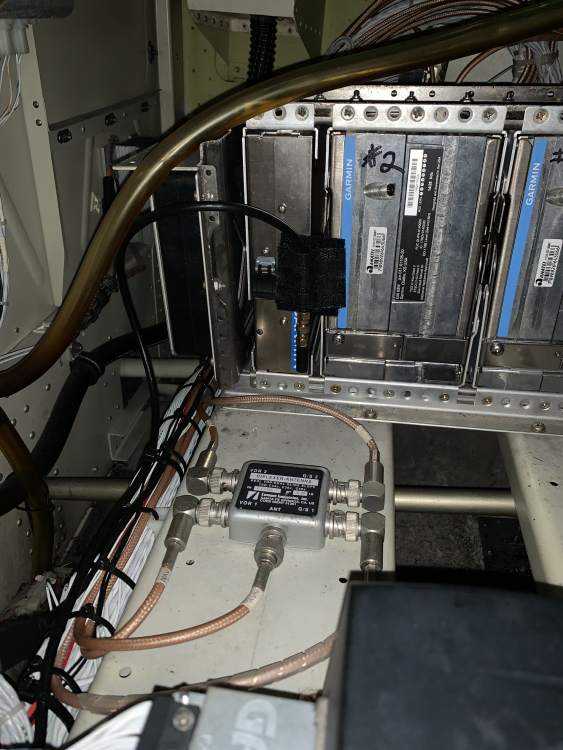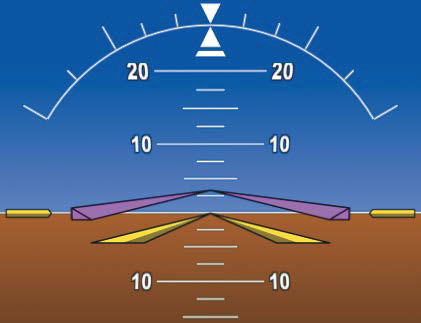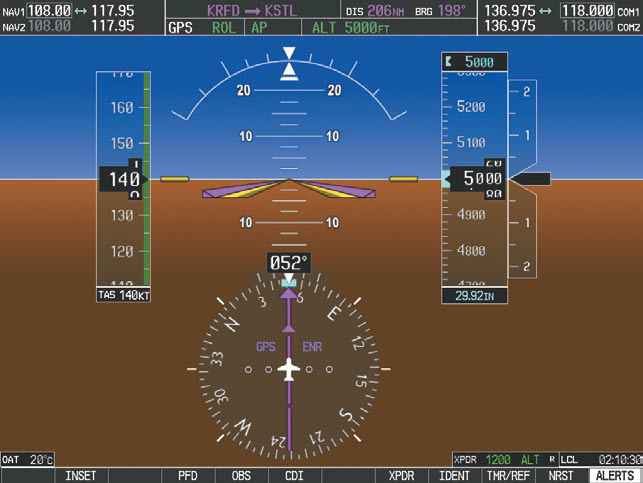
PaulM
Verified Member-
Posts
394 -
Joined
-
Last visited
Content Type
Profiles
Forums
Blogs
Gallery
Downloads
Events
Store
Everything posted by PaulM
-
G1000 message - Abort approach, GPS signal lost
PaulM replied to Yariv's topic in Modern Mooney Discussion
Yes, I have seen both... I have had a total GPS loss on an airway flying IFR just south of the Washington DC area. I just dialed in the VOR for the airway, switched the heading source and the GPS came back about 30 seconds later. I have also had it go LOI in the middle of a RNAV LPV approach, right when I was at the bottom of the cloud deck, so the runway was in sight. -
I've had the connector on both the MP and oil pressure go "odd" at times. A quick removal and squirt with contact cleaner has so far cleaned it up, but those were usually a bit of loss, not a complete zero. If it is an intermittent broken wire, I would try and flex the cable at the various points and see if you can reproduce the problem. A temp indicating below ambient will always be a failure, and of no risk to the flight.
-
lower 1600's... with the power back it runs in the upper 1500's.
-
The exhaust for the AF1A/B was built from Iconel, which has a higher temperature yield point. All of the AF1A and AF1B design tweaks were so that Mooney could fit the most power in the smallest space and advertise that top speed, but as you see you need to run at at 80% power, and at an exhaust temperature that burns up the exhaust. The welds at the 1st bend seem to fail first. (I also have a toasty TIT probe on my shelf). You can either run it at a good power, but ROP and use up fuel, or find the "peak" power that keeps the TIT below 1650 for best efficiency.
-
I have 2005 M20M only 33.5 inches of Manifold pressure on Take off.
PaulM replied to jhealan's topic in Mooney Bravo Owners
According to the Lycoming manual that is below the lowest MP setting on the density controller. Ask the annual shop what they "did" during the annual, they adjusted something. I would suggest that the procedures in the manual be followed for setting idle mixture and the density controller. The Bravo should run perfectly smoothly at sea level once warmed up. Mine has only glitched if there was a problem with either Mags, plugs, or high airport altitude. When I first flew the plane after I bought it it wouldn't go above 34-35" but this was Texas in December. Since I thought this was low, I brought it by Dmax on the way home and they tweaked the density controller to spec, but I didn't realize until reading the manual that lower temps == lower max MP. -
This is classic internal short behavior of thermocouples. The Seebeck effect that generates the voltage difference is from where the 2 dissimilar metals begin to where they are joined. The short simply joins them farther away from the probe tip. Intermittent "lower temperature" is a short... intermittent high/un-readable temp is an open circuit on one of the legs. All K type thermocouples are interchangeable. It probably failed and the local shop had Alcor on hand.
-
AOG Difficulties with 0401.37 G1000 Software- SOLVED
PaulM replied to LANCECASPER's topic in Acclaim Owners
You may want to think about the GTX33D /ES Canada is going to require top and bottom ADSB since they are using the aireon satellite system for their ADSB ATC requirements, that will probably affect the Canada Greenland route. I would have put in a GTX345RD if we had known it was going that way. And ASDB-in is useful anywhere that has ES transponders.. the ground re-transmitters are mostly only needed for UAT/ES mixed environments (US only) and the FIS-B weather service. -
AOG Difficulties with 0401.37 G1000 Software- SOLVED
PaulM replied to LANCECASPER's topic in Acclaim Owners
Actually I think the pull the breaker method is best... you will never have the "right" version if it expects a GTX33. -
AOG Difficulties with 0401.37 G1000 Software- SOLVED
PaulM replied to LANCECASPER's topic in Acclaim Owners
Why not update the GTX345R first... then when the G1000 update runs it sees V 2.54(example) and doesn't feel a need to do anything. If it fails they can always down-rev it again to the version your .32 likes. or just pull the breaker? then it won't be ID'd for update. I think the G1000 will just refuse to talk to a version of GTX345R that isn't in its manifest. I'm pretty sure the default software is only expecting a GTX33 so it fails. -
AOG Difficulties with 0401.37 G1000 Software- SOLVED
PaulM replied to LANCECASPER's topic in Acclaim Owners
Ok, a number of things.. #1.. the previous version is 0401.34.. and there were a bunch of things that if you didn't do them correctly would brick the GMU. I suggest that the last M20_305B be done first. If nothing else follow the GMU procedure in that SB. Done wrong the hardware needs to be RMA'd to garmin. Also that rev needed 4GB SANdisk cards for the NAV data, terrain, etc. The .37 update needs the ultra high res terrain database, so that will be a call to garmin to change your account to download that. (you will remember selecting the ARC-seconds every year when you renew your subscription) As you suspect the GTX 345R updates are done directly via USB to the transponder. (so is the configuration). This needs the Garmin GTX management software package. There is also usually a magic manifest to update the G1000 system to accept the latest GTX345R software that garmin techs can access directly. My shop did that last transponder check. I have also scheduled the 0401.37 update (perhaps next week).. So have the tech review the software rev required in the 0401.37 manifest. Update the GTX345R manually to that revision. Then install the software and it should "skip" the 345R update. Once that is done the Garmin tech can look for the latest GTD345R version and install that with the matching latest manifest. If you are an early STEC55X then there is the serial#'s for pre-rewire config and post-rewire. -
Aren't PowerFlow exhausts normally aspirated only?.. not turbo? I see only O- not even IO- in their STC list. The issue with the exhausts is that 1750 is essentially Iconel's limit, and the welds crack. The cylinder life was basically fixed by the Bravo mod, as long as you don't push the Aluminum yield temperature, 380C is where the bend starts. The TIO-540AF1A&B basically pushed the envelope in power, and heat dissapation in a small cowl and compact form factor. It will run there, but will burn through parts if you keep it in the hot/high power corner. Run it back at the limits for other TIO-540s (1650 etc) and it will run without complaint to TBO.
-
That is where I pretty much run my Bravo these days.. I used to run it harder, and kept hammering the exhaust. 22/32 lean to 1650 (peak).. Pick the MP entry where peak is 1650.. There is no difference between running LOP at tempX and running peak at tempX and less MP. Once you are at peak/LOP all heat/power is related to fuel flow. If the CHT's are above 380 I will let the cowl flaps trail open (switch to middle and let the air flow slowly open the flap)... the 2 kt loss from 1/2 open is less than the power loss from running further LOP or a lower MP. Overall this seems to give me about 10kts less (160kt base speed) than trying to run at 24/34 "peak/LOP", and If I need those speeds I will run the 24/34 ROP gas guzzling mode.
-
Tgreen, Have you read through these threads?.. I have found that as long as you hit the sequence that I outlined that it always captures the GS. Including all LNAV modes with guidance if you have WAAS. For just ILS capture, you must hit the APR button after the G1000 has switched to green needles, and that doesn't happen until the fix before the FAF. Even if you have hit the APR button before, without the precision flag from the nav radio the 55X won't arm the GS mode.
-
Don't go here: https://www.adsbexchange.com Or run your own ADSB receiver. The proposed defense for the high rollers will be pools of ICAO ID#s from 3rd party providers: https://adsbperformance.faa.gov/PIA/Application.aspx https://www.aopa.org/news-and-media/all-news/2019/december/24/ads-b-privacy-now-available Of course one Plane spotter and your anonymity is decloaked for the lifespan of the current ID.
-
You must have the top right "checklist" card in.. it logs the data in real time directly to the card. I have a 4GB card there... you will never fill the card up.
-
I update everything on the same 2 "lower" cards. (I swap between the 2 OEM Garmin 4GB and 2 Sandisk 4GB) I keep image copies (via dd) In case there is a file system corruption, it can be restored from the image as it came from Garmin. You do not have to follow garmin's method unless you want one special feature. The only difference between the PFD and MFD cards are that if you have Flight charts, they only need to be loaded on the MFD card. They will be ignored on the PFD card. I no longer pay for Flight Charts as I never used them, and only use Foreflight for approach charts. When new nav data is loaded, on boot the PFD and MFD see the nav_db2.bin file. and ask you to load it.. This copies the data from the SD card into internal flash, and upon the end of the loading process the SD card nav information is never used again. When the system boots fully, it verifies and uses the Terrain, SafeTaxi, FlightCharts, basemap, Airport directory From the corresponding lower cards. The only feature you loose is that If you load a future database (not yet valid) into the top card spot with a valid bottom card, garmin will allow you to position the new DB in a "next-up" location on the lower card for transfer after the Thursday morning cutover time. I see no point in this feature for us, perhaps it is for part 135 where an A&P is supposed to do the DB updates, and then the flight crew needs the new Thursday data when away from home base. I just put in the new cards for the 1st flight after Thursday morning. The latest systems V14.x also allow you to only update the Terrain, ST, FC, BM, AD in the MFD and have the GDU's sync the data from the MFD to the PFD card automatically. As this takes so much time (people say 30 mins?). it is just easier in 2 display systems to just have 2 sets of cards. Perhaps in the 3 display systems it would be of use. A 4GB FAT32 card sits in the MFD upper slot for the checklist and data logging. . Every 3-4 months I will upload that data to Savvy (sooner if I had an issue to diagnose) Otherwise I don't touch it. Please don't reply back with "garmin says"... I know what garmin says. I am just saying "this is what I do" nobody else has to do it.
-
ANY reason not to jack up one wing at a time to change a tire?
PaulM replied to DaveMC's topic in Mooney Bravo Owners
No problems with that, My on field mechanic did just that for my last flat. -
Yes that was Garmin's solution to the problem Connect the FS210 to only the GTX345R. We have found that this passive antenna combo does the job for <$100. We also know that Garmin did support the FS210 in the G1000 system (Software rev 15.x).. since both Cirrus and TBM had them. Of course since Mooney didn't include it in the manifest they can't say it is supported for us. Anthony, yes the thing in the little blue circle.
-
To update a dead thread. I switched the antenna in front of the blue sticker to a much smaller stub antenna. Now I get zero disconnects even with full people or bags.
-
There is no official way. Since they are not certified AWOS/ASOS , I guess that the FAA has zero interest in putting it in the AFD remarks. RMK: VFR Advisory weather available on CTAF 123.0 3 clicks A private indicator is that if there is on field weather in Foreflight, but not a listed ASOS/AWOS, then I would give three clicks a try. On most VFR days there will be enough traffic that someone is going to trigger the system.
-
The Digi-WX systems are dead technology. The business (Belfort?) must be supporting them in some minimal way. The systems are XP based, and I'm amazed that the infrastructure still functions, looks like the domains are AWS fronted.. So there must be some minor ongoing support still available. I'll ask the airport manager at 1N7 the next time I see him. I know the DSL link connecting it hasn't been touched in 10+ years. I know that N87 (Robinsville) had all of the sensors fail. The only thing they are official for is the altimeter setting. All other indications are advisory.
-
KABE near me has "RVR 1800 authorized with use of FD or AP or HUD to DA"
-
The yellow V is just the standard AI center indicator. It only gives you a reference to the artificial horizon. It does not tell you to fly left or right, up or down on an approach. The command bars are where you couple the autopilot in FD mode and if you put the yellow V into the purple command V then you will be flying the plane as if the AP was connected. If in APR mode, then it will tell you to turn left.. go down etc. For example these command bars are telling you that you should be pitching up to climb.. It is used where you want to be in manual control, but have the extra backup of what would "Otto" do. Jet pilots use them for takeoff, and go arounds.. hit the TOGA button etc. for us, there isn't much use other than perhaps turbulence where you would want to hand fly and not just let the AP do its job. With our G1000 Stec system, we don't have the FD option... when you engage the AP, the purple command bars will appear and the AP takes over... you can watch and as the AP maneuvers the bars will float around as the system commands climbs, turns, etc.
-
Do you mean the SVT Flight path marker.. or green meatball? you put the ball on the runway, or horizon and you will end up there. That is not related to the autopilot system. If you are talking about the yellow bars to the side, that is just the normal "level" AI bars. the yellow V is always there.. the Purple bars are the command bars and are only in AP/FD mode.





